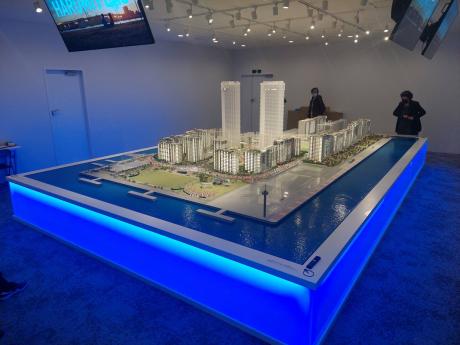Tokyo Olympics athlete village to become smart city
The 2020 Tokyo Olympic and Paralympic athletes’ village in the heart of the metropolis will be transformed as first smart city by 2024. comprising residential and commercial space and powered by hydrogen energy as a primary source.
This as the metropolitan government advances efforts towards their goal of a decarbonised society with net zero CO2 emissions by 2050.
Their mid-term goal for 2030, to halve greenhouse gas emissions, is in line with Jamaica’s renewable energy plan outlined in its ‘Vision 2030’, the country’s first long-term strategic development plan.
The Tokyo Metropolitan Government says their agenda is to reduce energy consumption and increase the use of renewable energy. This is where hydrogen, a clean fuel that when consumed, produces only water, comes in.
Hydrogen can be made from a variety of resources, contributing to a stable energy supply that can be stored and used when needed.
Work is in progress to finish converting the former athletes’ village into a shiny new town named Harumi Flag. Two thousand of the homes in the waterfront Harumi district have already been sold.
Prices of the units range from ¥50 million (J$ 51 million approximately) to of ¥200 million (J$204 million approx). Rental units are estimated to be around ¥200,000 (Little over J$ 200,000) to ¥300,000 (around J$ 300,000) per month.
Akio Kajiyama, deputy director of the Urban Redevelopment Section, at the Tokyo Metropolitan Government, told journalists from the Caribbean and Pacific that transforming the housing for Olympic athletes into a residential community and with hydrogen power was always the end goal following the Tokyo 2020 Olympics.
Through a translator, he said, “There are 21 of these buildings. Currently the renovation is done inside the individual room(s), and the idea is that they will be sold like any commercial condominium.” Kajiyama said 4,145 condominiums will be placed on the market while 1,487 will be rented.
RETROFIT COMMERCIAL AREA
The development will retrofit a commercial area used during the Games to include a supermarket and a nursery. Two 50-storey condominiums are being built as part of the overall residential plan.
“Once everything is completed, we are assuming it will be a community of 12,000 inhabitants,” Kajiyama said.
Hideki Kiso, another deputy director, said that when the construction is completed, an on-site hydrogen station will be built. During the 2020 Olympic Games hydrogen produced in Fukushima Prefecture was used at the athletes’ village to operate a relaxation space, as well as the torch relay and cauldron.
This was the first-ever hydrogen powered torch in the history of the Games as the metropolitan government promoted the use of green hydrogen.
“The relaxation room had three massage chairs, three air pumps and three big monitors, and all electricity came by utilising this hydrogen,” Kiso said.
The hydrogen was stored in tanks during the Games that had to be covered, as they are vulnerable to heat. The hydrogen station to be built down the road will remedy those effects.
Ryosuke Mizutani, deputy director of the Urban Redevelopment Section, at the Tokyo Metropolitan Government, took journalists for a tour of the 4900-square-metre property.
“(Hydrogen) will be made in this location and stored in fuel cells,” he said, adding that installation of an underground pipeline beneath the road is already complete. “(Hydrogen) will be mixed with other electricity source, and together (they) will be used for general electricity source for the area,” he said.
The station will feature hydrogen production and supply, car-sharing service parking and an energy education facility. The works at the residential community are on schedule for March 2024, when residents are expected to start moving in.
Ayumu Furuya is a principal of Mitsui Fudosan Residential Company Limited, one of 10 companies in charge of selling and renting the units in the high-rise condos being built. It is expected to be completed in September 2025.
“The athletes’ village is something that the host nation has to figure how to use it afterwards, because if you build something of this scale far from the city centre it would be extremely difficult to sell or rent,” Furuya said with assistance of an interpreter, noting that the central location of the development is ideal.
Furuya said sales have skyrocketed. He said one characteristic of the development is that in the event of a power cut or natural disaster, it can sustain itself for one week because of the hydrogen technology.
According to the Tokyo government, their aim by 2030 is to have one million fuel cells for residential use. There were 67,000 at the end of 2020.



